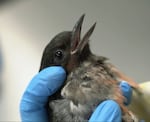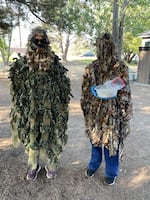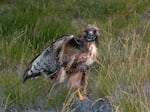Veterinarian Laura Acevedo wraps a groggy red-tailed hawk’s talons with surgical tape in the operating room at the Think Wild hospital and conservation center in Bend.
“This is for our protection,” she explains. “If she decides that she wants to wake up in the middle of anesthesia for one reason or another.”
Wildlife technician Taylor Dimmick completes Acevedo’s thought: “It’s like your patient suddenly has a steak knife on the table.”
“Eight steak knives,” chuckles Acevedo.
Once the razor-sharp talons are safely wrapped, the team from this nonprofit wild animal hospital sets about extracting a bullet from the hawk’s wing.
It’s just another day at this busy facility that was created to help solve the kinds of problems that come up when people move into wildlife habitat, as we have been doing all over Oregon, and especially in Bend.

Think Wild veterinarian Laura Acevedo examines the wings of a red-tailed hawk before performing surgery to remove a bullet in this image captured from video footage on July 29, 2022.
Brandon Swanson / OPB
The feisty raptor arrived at Think Wild a few weeks earlier with a wing broken by the impact of a bullet. Fortunately, Acevedo says, the ulna bone in the wing where the bullet hit was well-aligned, with a good chance of full recovery. But she’s concerned about the bullet for other reasons.
“Just like anything, the body starts to develop scar tissue,” Acevedo says. “It starts to kind of wall things off if it doesn’t want it there. So, I’m either gonna have to get through a big capsule of bone or a big capsule of tissue.”
The area also contains tendons and ligaments that are essential to flight. The risk of severing or injuring one of them while removing the bullet is high.
“I’m cautiously optimistic,” she says, “but if I get in there, and it requires breaking the bone to get it, I’m not gonna do it.”
Still, if she leaves the bullet in place, the hawk runs the risk of lead poisoning, which can cause neurological damage. In that case, the hawk will have to be euthanized.
Once Acevedo secures the talons and examines the broken wing more closely, she lets out a small gasp.
“That’s loose. That’ll fall out,” she says, referring to the bullet. Dimmick responds with a small “woot!” The two women’s eyes squint into smiles behind their surgical masks.
Within 10 minutes, Acevedo removes the slug and drops it into a metal bowl with a small plink.
“Thankfully it was superficial — super-superficial,” she reports. “I don’t know if the body was trying to push it out or what, but that was an ideal bullet removal.”
Volunteers to the rescue

Baby birds that have fallen from nests or been abandoned often show up at Bend's Think Wild animal hospital during the summer fledging season. They are hand-fed by volunteers several times a day, as shown in this image captured from video footage July 29, 2022.
Brandon Swanson / OPB
The injured hawk is one of a couple dozen wild animals being cared for by the team today. In the three years Think Wild’s been operating, they’ve built a rescue network of more than 100 volunteers that covers a good part of Central Oregon.
“A lot of times our volunteers can actually go out and assess the situation and capture and bring the animal to us,” Think Wild executive director Sally Compton explains. “But in situations where the animal might be hard to capture or there’s potentially a dangerous situation, that’s when staff will go out and do the capture ourselves.”
The hospital is busy. On any given summer day, the hotline can field upwards of 30 calls, about half of which can be handled over the phone.
“We really encourage people to call our hotline if they see injured or orphaned animal, if they have wildlife questions or concerns,” Compton says.
It can really be anything, too. People can call the hotline if they see an injured hawk on the side of the road or if they find a raccoon nesting under their deck and want to keep their pet safe.
“So we sort of see the hotline as this all-encompassing resource for anything wildlife-related in Central and Eastern Oregon,” she says.
Related: This great gray owl persevered with help from Think Wild after flying into a Sunriver window 🦉
Supported exclusively by grants and private donations, Think Wild treats and rehabilitates a variety of sick, injured and orphaned wild creatures.
For safety reasons and because of state regulations, the hospital is restricted from treating adult deer, bears, cougars, coyotes and wolves. It’s not currently taking fawn, but according to Compton it is working on building a fawn enclosure so that it can be one of the only public centers in Oregon to rehabilitate fawn this summer.
Keeping it wild
About 60-70% of Think Wild’s calls are about birds, often babies that have fallen from nests in their first attempts to fly. Many end up in the facility’s avian nursery, where volunteers tweeze wriggling mealworms into gaping mouths throughout the day. The volunteers wear camouflage “ghillie” suits, meant to spare their tiny patients the stress of encountering humans, whom they interpret as predators. That’s partly because stress can be deadly.
“These aren’t dogs and cats that seek out human attention,” Compton says. “They’re already severely stressed because they’re injured or orphaned, so they already have these really elevated stress levels. And so we really want to mitigate stress anyway that we can.”

Staff at Bend's Think Wild animal hospital and conservation center wear camouflage "ghillie" suits to reduce the stress human interaction can have on wild animals on July 29, 2022.
Jule Gilfillan / OPB
Another reason for the precautions is to make sure the wild animals stay wild.
“This isn’t an animal that will be in a zoo or an exhibit,” she says. “This is an animal that needs to go back into the wild and not look to humans as a source of food.”
Outside, quiet enclosures provide rehab zones for mourning doves, skunks, raccoons and a collection of raptors. The larger spaces allow recovering birds to rebuild flight skills so they can capture prey effectively once released back into the wild — if they make it that far.
“We sort of see the wildlife hospital as like, you know, a last stop, last resort,” Compton says. “The reality of wildlife rehabilitation is that a lot of injuries that the animals have are life-threatening, and a lot of times it can prevent them from ever being releasable or ever being able to survive in the wild.”
Free bird
Three weeks after the successful surgery, the bullet-free red-tailed hawk is ready for release just east of Sisters where she was found. The fidgety bird clearly wants out; Acevedo throws veterinary technician Caroline Read a cautionary glance as the bird’s thrashing rocks the transport box she’s carrying into the sagebrush.
Acevedo carefully undoes the box clasps, wraps the impatient patient in a terry cloth towel and lifts her out of the box. It takes a good minute for Read to pry the hawk’s talons from the towel before turning her attention to removing the leather hood they put on at the hospital to keep the raptor calm. Once that’s removed, Acevedo swings the hawk’s body into the air, thrusting it toward the open sky.
But instead of stretching her wings in her first free flight in months, the mighty raptor flutters down, landing on the ground about 10 feet away and looks confused. Acevedo sighs.
While Acevedo and Read ponder what to do next, the big bird totters away, wings partially spread, as though she’s fixing to perform a dance.
“She’s running like a chicken, but she can fly,” explains an exasperated Acevedo. “She’s probably just so stressed.”

In this image captured from video footage Aug. 18, 2022, a rehabilitated red-tailed hawk is ready for release back into the wild... or is she?
Brandon Swanson / OPB
A few minutes after blundering into a thatch of young Ponderosa pines and disappearing from view, the red-tail is spotted up on a limb of one of the taller pines — proof that she can indeed fly. A moment later, a powerful flap of her two big wings propels the free bird toward the horizon and out of sight.
Acevedo lets out a sigh of relief followed by a laugh: “So she’s on her way, but apparently on her own terms.”
For the Think Wild team, it’s the best possible outcome to a situation that’s not likely to change.
“Obviously Bend and Central Oregon are growing very quickly, which means more people are interacting with wildlife,” Compton says.
She hopes that centers like Think Wild can help Bend and other cities to grow in a way that works for both people and wildlife.
